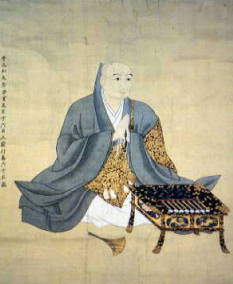Hon'inbō Sansa facts for kids
Quick facts for kids Honinbo Sansa |
|
|---|---|
 |
|
| Full name | Honinbo Sansa |
| Kanji | 本因坊算砂 |
| Born | 1559 Kyoto, Japan |
| Died | June 13, 1623 Edo, Japan |
| Teacher | Senya |
| Rank | 9 dan |
Hon'inbō Sansa (本因坊 算砂, 1559 – June 13, 1623) was a super strong Japanese Go player. He lived during the Edo period (1603–1867), a time when Japan was ruled by powerful shoguns. Sansa was the person who started the Hon'inbō house, which became the first and most important of the four big schools of Go in Japan. His original name was Kanō Yosaburō (加納 與三郎), and he was also a Buddhist priest. His priest name was Nikkai (日海).
Contents
Life and Career of Hon'inbō Sansa
Early Life and Becoming a Monk
Nikkai was born in Kyōto, a famous city in Japan. When he was just nine years old, he became a monk. The name "Hon'inbō" comes from a special sub-temple of the Jakkōji temple complex in Kyōto. This is where Nikkai, who was the first "Hon'inbō," lived and studied.
Playing Go with Japan's Leaders
Nikkai taught Go to some of the most important leaders in feudal Japan. These leaders were called daimyō, which means powerful lords. His students included Oda Nobunaga, Toyotomi Hideyoshi, and Tokugawa Ieyasu. These three men are famous for bringing all of Japan together under one rule. Nikkai thought they were pretty good Go players, but he was also very polite to them!
The First Go Meijin
In 1578, when Nikkai was twenty years old, Nobunaga recognized him as the very first Meijin of Go. This was a huge honor, meaning he was the top Go player.
A famous Go game happened in 1582 at the Honnōji Temple. Nikkai played against another priest named Kashio Rigen. This game is special because it supposedly happened just before a big event where Nobunaga faced a difficult situation and died. People say the game ended in a "triple ko". A triple ko is a very rare situation in Go where three groups of stones are in a repeating cycle. Some people thought it was a bad sign! We have a record of the game, but it's not complete, so the triple ko part might just be a cool story.
Official Support for Go
After Nobunaga, Toyotomi Hideyoshi became the new leader. In 1587, Hideyoshi gave Nikkai an official job. This job was like an early version of the Go-dokoro office, which was in charge of Go. Hideyoshi also gave Nikkai's temple an annual gift of rice and even watched a Go tournament in person. In 1592, the Go-Yōzei Emperor gave Nikkai an important rank called Gon-no-Daisoku.
Becoming Hon'inbō Sansa and the Go-dokoro
In 1603, Tokugawa Ieyasu became the shōgun, starting the Tokugawa government that lasted for 250 years. Ieyasu wanted Nikkai to focus on Go. So, Nikkai gave his priest duties at Jakkoji temple to his younger brother. Nikkai then became the first go-dokoro, the official head of Go. This job came with a good amount of rice and servants. Around 1605, Nikkai took the name Hon'inbō Sansa. The name Sansa means "calculating sand."
Sansa was also a strong shogi player, which is like Japanese chess. But during the Tokugawa period, Go was organized into four main "houses" or schools, and Shogi into three. These schools would compete in special tournaments called oshirogo (or "Castle Go") for the Meijin title. Because Go and Shogi were official, their masters had different jobs. In 1612, eight Go and Shogi players started getting money from the government. This system lasted for over 250 years, until the Tokugawa government ended.
The "Castle Go" matches were held in Edo, which was the capital city of the Tokugawa government. This meant Sansa had to travel to Edo for a month each year. He didn't want to live in Edo permanently, but he was given other places to stay. Sansa died in Edo when he was 65 years old.
Hon'inbō Sansa's Legacy
Continuing the Hon'inbō House
After Hon'inbō Sansa passed away, a young student named Sugimura took over. He had to wait a few years because he was so young. When he turned twenty, he officially restarted the Hon'inbō house as Hon'inbō San'etsu.
The Hon'inbō house became very famous. Seven out of ten of the historic Meijin (the top Go players) came from the Hon'inbō house. Also, all three traditional Kisei ("Go Sages") were Hon'inbō masters. Today, the Meijin and Kisei titles are managed by the Nihon Ki-in, a big Go organization.
The End of the Traditional Houses
The school that Hon'inbō Sansa started, along with the Inoue and Yasui schools, continued for a long time, even into the 20th century. However, they struggled when they no longer had government support. In 1936, the last Hon'inbō master, Hon'inbō Shūsai, decided to let the Nihon Ki-in choose who would hold the Hon'inbō title. This led to the modern Honinbo Tournament.

